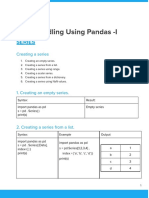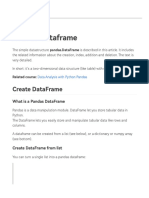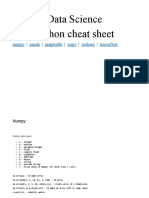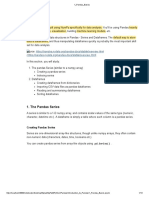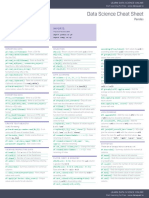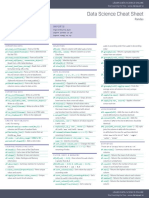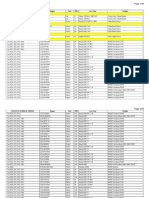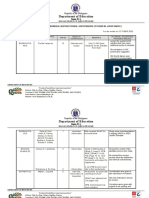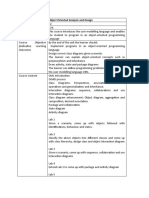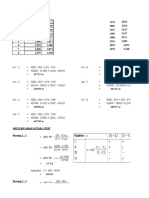🐼
Pandas Cheatsheet
KEY IMPORTS
We’ll use shorthand in this Import these to start
cheat sheet import pandas as pd
import numpy as np
df - A pandas DataFrame
object
s - A pandas Series object
IMPORTING DATA
If file you are importing is in different directory so in place of filename, write path
of your file.
CODE WORKING
pd.read_csv(filename) From a CSV file
pd.read_table(filename) From a delimited text file (like TSV)
pd.read_excel(filename) From an Excel file
pd.read_sql(query, connection_object) Reads from a SQL table/database
pd.read_json(json_string) Reads from a JSON formatted string, URL or file.
Pandas Cheatsheet 1
� CODE WORKING
From a dict, # keys for columns names, # values for
pd.DataFrame(dict)
data as lists.
EXPORTING DATA
CODE WORKING
df.to_csv(filename) Writes to a CSV file
df.to_excel(filename) Writes to an Excel file
df.to_sql(table_name,
Writes to a SQL table
connection_object)
df.to_json(filename) Writes to a file in JSON format
VIEWING/INSPECTING DATA
CODE WORKING
df.head(n) First n rows of the DataFrame
df.tail(n) Last n rows of the DataFrame
df.shape Number of rows and columns
df.info( ) Index, Datatype and Memory information
df.describe( ) Summary statistics for numerical columns
s.value_counts(dropna=False) Views unique values and counts
df.apply(pd.Series.value_counts) Unique values and counts for all columns
SELECTION
CODE WORKING
df[col] Returns column with label col as series
df[[col1, col2]] Returns Columns as a new DataFrame
s.iloc[0] Selection by position
s.loc[0] Selection by index
df.iloc[0, :] First row
df.iloc[0, 0] First element of first column
Pandas Cheatsheet 2
� DATA CLEANING
CODE WORKING
df.columns = ['a', 'b', 'c'] Renames columns
pd.isnull() Checks for null Values, Returns Boolean Array
pd.notnull() Opposite of s.isnull()
pd.dropna() Drops all rows that contain null values
df.dropna(axis=1) Drops all columns that contain null values.
Drop all columns that have fewer than n non-NaN
df.dropna(thresh=n)
values
df.fillna(x) Replaces all null values with x
Replaces all null values with the mean(mean can
s.fillna(s.mean()) be replaced with almost any function from the
statistics section)
s.astype(float) Converts the datatype of the series to float
s.replace(1, 'one') Replaces all values equal to 1 with ‘one’
s.replace([1, 3], ['one', 'three']) Replaces all 1 with ‘one’and 3 with ‘three’
df.rename(columns=lambda x: x + 1) Mass renaming of columns
df.rename(columns={'old_name':
Selective renaming
'new_name'})
df.set_index('column_one') Changes the index
df.rename(index = lambda x: x + 1) Mass renaming of index
FILTER, SORT, & GROUPBY
CODE WORKING
df[df[col] > 5] Rows where the col column is greater than 5
df[(df[col] > 5) & (df[col] < 7)] Rows where 7 > col > 5
df.sort_values(col1) Sorts values by col1 in ascending order
df.sort_values(col2, ascending = False) Sorts values by col2 in descending order
df.sort_values([col1, col2], ascending = Sorts values by col1 in ascending order then
[True, False]) col2 in descending order.
Returns a groupby object for values from one
df.groupby(col)
columns
Pandas Cheatsheet 3
� CODE WORKING
Returns a groupby object values from multiple
df.groupby([col1, col2])
columns
Returns the mean of the values in col2, grouped
df.groupby(col1)[col2].mean( ) by the values in col1 (mean can be replaced with
almost any function from the statistics section)
Finds the average across all columns for every
df.groupby(col1).agg(np.mean)
unique column 1 group
df.apply(np.mean) Applies a function across each column
df.apply(np.max, axis = 1) Applies a function across each row.
JOIN/COMBINE
CODE WORKING
Adds the rows in df1 to the end of df2(columns
df1.append(df2)
should be identical)
Adds the columns in df1 to the end of df2 (rows
pd.concat([df1, df2], axis=1)
should be identical)
STATISTICS
CODE WORKING
df.describe( ) Summary statistics for numerical columns
df.mean( ) Returns the mean of all columns
Returns the correlation between columns in a
df.corr( )
DataFrame
Returns the number of non-null values in each
df.count( )
DataFrame column
df.max( ) Return the highest value in each column
df.min( ) Returns the lowest value in each column
df.median( ) Returns the median of each column
df.std( ) Returns the standard deviation of each column
Pandas Cheatsheet 4

































